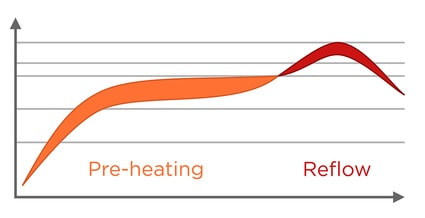When soldering electronic components onto printed circuit boards (PCBs) through the reflow soldering process, different types of reflow profiles are used to control the temperature profile during soldering. The choice of reflow profile depends on factors such as the solder paste used, component types, PCB design, and thermal requirements. Here are some common types of reflow profiles:
The selection of the appropriate reflow profile is critical to achieving reliable solder joints and preventing defects like solder voids, component damage, or solder balling. It should be based on a thorough understanding of the components, solder paste, and PCB design, as well as compliance with industry standards and regulations. Additionally, process validation and testing are essential to ensure that the chosen profile meets the specific requirements of the assembly.
- Standard (Single-Profile) Reflow Profile:
- A single, uniform temperature profile is used for the entire assembly.
- Typically used for general SMT (Surface Mount Technology) components and PCBs with uniform thermal requirements.
- Simple and easy to implement.
- Lead-Free (RoHS) Reflow Profile:
- Designed specifically for lead-free solder alloys, such as SAC (Sn-Ag-Cu).
- Involves higher reflow temperatures and longer time above the liquidus temperature compared to leaded profiles.
- Required for compliance with RoHS (Restriction of Hazardous Substances) regulations.
- Leaded Reflow Profile:
- Designed for solder alloys containing lead (Pb) in compliance with older standards.
- Involves lower reflow temperatures and shorter time above the liquidus temperature compared to lead-free profiles.
- Ramp-Soak-Spike (RSS) Reflow Profile:
- Involves a controlled ramp-up to a soak or dwell temperature, followed by a rapid spike to the peak reflow temperature.
- Used for components sensitive to thermal shock or to prevent certain defects like tombstoning.
- Offers improved process control for specific applications.
- Multi-Zone Reflow Profile:
- Uses multiple heating zones along the length of the reflow oven.
- Allows for precise temperature control and optimization for different sections of the PCB.
- Beneficial for complex assemblies with various component sizes and thermal requirements.
- Double (Two-Profile) Reflow Profile:
- Involves two separate temperature profiles, each with different peak temperatures and soak times.
- Used for mixed-technology assemblies with both SMT and through-hole components.
- Prevents excessive heat exposure to sensitive through-hole components during the first pass.
- Customized Reflow Profile:
- Tailored to specific component or assembly requirements.
- May involve unique temperature ramps, soak times, and peak temperatures.
- Developed through experimentation and validation for special applications.
- Low-Temperature Reflow Profile:
- Utilizes lower peak temperatures to accommodate temperature-sensitive components or substrates.
- Can be beneficial for assemblies with components that have low melting points or are sensitive to heat.
- High-Temperature Reflow Profile:
- Involves higher peak temperatures for assemblies that require strong solder joints and increased thermal reliability.
- Suitable for applications with high operating temperatures or harsh environments.
The selection of the appropriate reflow profile is critical to achieving reliable solder joints and preventing defects like solder voids, component damage, or solder balling. It should be based on a thorough understanding of the components, solder paste, and PCB design, as well as compliance with industry standards and regulations. Additionally, process validation and testing are essential to ensure that the chosen profile meets the specific requirements of the assembly.
|
Return to home page
|

